Guanxiong Luo
DeblurSDI: Blind Image Deblurring Using Self-diffusion
Oct 31, 2025Abstract:Blind image deconvolution is a challenging ill-posed inverse problem, where both the latent sharp image and the blur kernel are unknown. Traditional methods often rely on handcrafted priors, while modern deep learning approaches typically require extensive pre-training on large external datasets, limiting their adaptability to real-world scenarios. In this work, we propose DeblurSDI, a zero-shot, self-supervised framework based on self-diffusion (SDI) that requires no prior training. DeblurSDI formulates blind deconvolution as an iterative reverse self-diffusion process that starts from pure noise and progressively refines the solution. At each step, two randomly-initialized neural networks are optimized continuously to refine the sharp image and the blur kernel. The optimization is guided by an objective function combining data consistency with a sparsity-promoting L1-norm for the kernel. A key innovation is our noise scheduling mechanism, which stabilizes the optimization and provides remarkable robustness to variations in blur kernel size. These allow DeblurSDI to dynamically learn an instance-specific prior tailored to the input image. Extensive experiments demonstrate that DeblurSDI consistently achieves superior performance, recovering sharp images and accurate kernels even in highly degraded scenarios.
Unsupervised Radar Point Cloud Enhancement via Arbitrary LiDAR Guided Diffusion Prior
May 15, 2025Abstract:In industrial automation, radar is a critical sensor in machine perception. However, the angular resolution of radar is inherently limited by the Rayleigh criterion, which depends on both the radar's operating wavelength and the effective aperture of its antenna array.To overcome these hardware-imposed limitations, recent neural network-based methods have leveraged high-resolution LiDAR data, paired with radar measurements, during training to enhance radar point cloud resolution. While effective, these approaches require extensive paired datasets, which are costly to acquire and prone to calibration error. These challenges motivate the need for methods that can improve radar resolution without relying on paired high-resolution ground-truth data. Here, we introduce an unsupervised radar points enhancement algorithm that employs an arbitrary LiDAR-guided diffusion model as a prior without the need for paired training data. Specifically, our approach formulates radar angle estimation recovery as an inverse problem and incorporates prior knowledge through a diffusion model with arbitrary LiDAR domain knowledge. Experimental results demonstrate that our method attains high fidelity and low noise performance compared to traditional regularization techniques. Additionally, compared to paired training methods, it not only achieves comparable performance but also offers improved generalization capability. To our knowledge, this is the first approach that enhances radar points output by integrating prior knowledge via a diffusion model rather than relying on paired training data. Our code is available at https://github.com/yyxr75/RadarINV.
Robust Simultaneous Multislice MRI Reconstruction Using Deep Generative Priors
Jul 31, 2024



Abstract:Simultaneous multislice (SMS) imaging is a powerful technique for accelerating magnetic resonance imaging (MRI) acquisitions. However, SMS reconstruction remains challenging due to the complex signal interactions between and within the excited slices. This study presents a robust SMS MRI reconstruction method using deep generative priors. Starting from Gaussian noise, we leverage denoising diffusion probabilistic models (DDPM) to gradually recover the individual slices through reverse diffusion iterations while imposing data consistency from the measured k-space under readout concatenation framework. The posterior sampling procedure is designed such that the DDPM training can be performed on single-slice images without special adjustments for SMS tasks. Additionally, our method integrates a low-frequency enhancement (LFE) module to address a practical issue that SMS-accelerated fast spin echo (FSE) and echo-planar imaging (EPI) sequences cannot easily embed autocalibration signals. Extensive experiments demonstrate that our approach consistently outperforms existing methods and generalizes well to unseen datasets. The code is available at https://github.com/Solor-pikachu/ROGER after the review process.
Autoregressive Image Diffusion: Generation of Image Sequence and Application in MRI
May 24, 2024



Abstract:Magnetic resonance imaging (MRI) is a widely used non-invasive imaging modality. However, a persistent challenge lies in balancing image quality with imaging speed. This trade-off is primarily constrained by k-space measurements, which traverse specific trajectories in the spatial Fourier domain (k-space). These measurements are often undersampled to shorten acquisition times, resulting in image artifacts and compromised quality. Generative models learn image distributions and can be used to reconstruct high-quality images from undersampled k-space data. In this work, we present the autoregressive image diffusion (AID) model for image sequences and use it to sample the posterior for accelerated MRI reconstruction. The algorithm incorporates both undersampled k-space and pre-existing information. Models trained with fastMRI dataset are evaluated comprehensively. The results show that the AID model can robustly generate sequentially coherent image sequences. In 3D and dynamic MRI, the AID can outperform the standard diffusion model and reduce hallucinations, due to the learned inter-image dependencies.
Autoregressive Image Diffusion: Generating Image Sequence and Application in MRI
May 23, 2024



Abstract:Magnetic resonance imaging (MRI) is a widely used non-invasive imaging modality. However, a persistent challenge lies in balancing image quality with imaging speed. This trade-off is primarily constrained by k-space measurements, which traverse specific trajectories in the spatial Fourier domain (k-space). These measurements are often undersampled to shorten acquisition times, resulting in image artifacts and compromised quality. Generative models learn image distributions and can be used to reconstruct high-quality images from undersampled k-space data. In this work, we present the autoregressive image diffusion (AID) model for image sequences and use it to sample the posterior for accelerated MRI reconstruction. The algorithm incorporates both undersampled k-space and pre-existing information. Models trained with fastMRI dataset are evaluated comprehensively. The results show that the AID model can robustly generate sequentially coherent image sequences. In 3D and dynamic MRI, the AID can outperform the standard diffusion model and reduce hallucinations, due to the learned inter-image dependencies.
Noise Level Adaptive Diffusion Model for Robust Reconstruction of Accelerated MRI
Mar 08, 2024Abstract:In general, diffusion model-based MRI reconstruction methods incrementally remove artificially added noise while imposing data consistency to reconstruct the underlying images. However, real-world MRI acquisitions already contain inherent noise due to thermal fluctuations. This phenomenon is particularly notable when using ultra-fast, high-resolution imaging sequences for advanced research, or using low-field systems favored by low- and middle-income countries. These common scenarios can lead to sub-optimal performance or complete failure of existing diffusion model-based reconstruction techniques. Specifically, as the artificially added noise is gradually removed, the inherent MRI noise becomes increasingly pronounced, making the actual noise level inconsistent with the predefined denoising schedule and consequently inaccurate image reconstruction. To tackle this problem, we propose a posterior sampling strategy with a novel NoIse Level Adaptive Data Consistency (Nila-DC) operation. Extensive experiments are conducted on two public datasets and an in-house clinical dataset with field strength ranging from 0.3T to 3T, showing that our method surpasses the state-of-the-art MRI reconstruction methods, and is highly robust against various noise levels. The code will be released after review.
Generative Image Priors for MRI Reconstruction Trained from Magnitude-Only Images
Aug 04, 2023



Abstract:Purpose: In this work, we present a workflow to construct generic and robust generative image priors from magnitude-only images. The priors can then be used for regularization in reconstruction to improve image quality. Methods: The workflow begins with the preparation of training datasets from magnitude-only MR images. This dataset is then augmented with phase information and used to train generative priors of complex images. Finally, trained priors are evaluated using both linear and nonlinear reconstruction for compressed sensing parallel imaging with various undersampling schemes. Results: The results of our experiments demonstrate that priors trained on complex images outperform priors trained only on magnitude images. Additionally, a prior trained on a larger dataset exhibits higher robustness. Finally, we show that the generative priors are superior to L1 -wavelet regularization for compressed sensing parallel imaging with high undersampling. Conclusion: These findings stress the importance of incorporating phase information and leveraging large datasets to raise the performance and reliability of the generative priors for MRI reconstruction. Phase augmentation makes it possible to use existing image databases for training.
Generalized Deep Learning-based Proximal Gradient Descent for MR Reconstruction
Nov 30, 2022Abstract:The data consistency for the physical forward model is crucial in inverse problems, especially in MR imaging reconstruction. The standard way is to unroll an iterative algorithm into a neural network with a forward model embedded. The forward model always changes in clinical practice, so the learning component's entanglement with the forward model makes the reconstruction hard to generalize. The proposed method is more generalizable for different MR acquisition settings by separating the forward model from the deep learning component. The deep learning-based proximal gradient descent was proposed to create a learned regularization term independent of the forward model. We applied the one-time trained regularization term to different MR acquisition settings to validate the proposed method and compared the reconstruction with the commonly used $\ell_1$ regularization. We showed ~3 dB improvement in the peak signal to noise ratio, compared with conventional $\ell_1$ regularized reconstruction. We demonstrated the flexibility of the proposed method in choosing different undersampling patterns. We also evaluated the effect of parameter tuning for the deep learning regularization.
Deep, Deep Learning with BART
Feb 28, 2022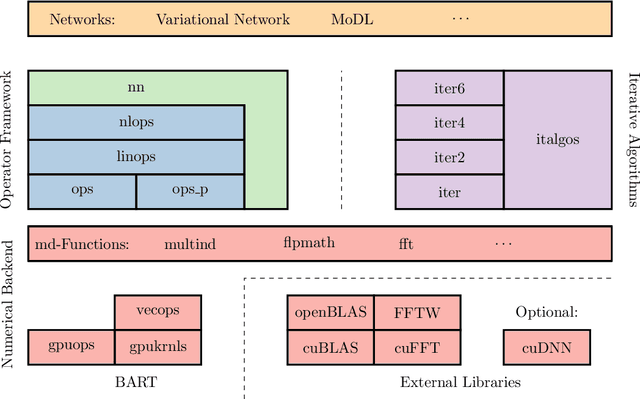
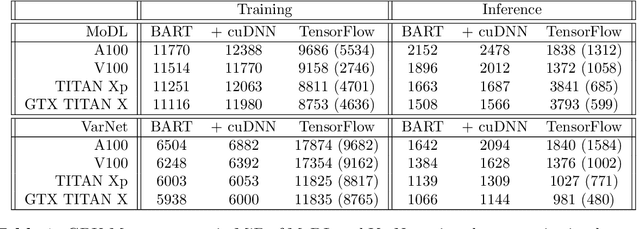
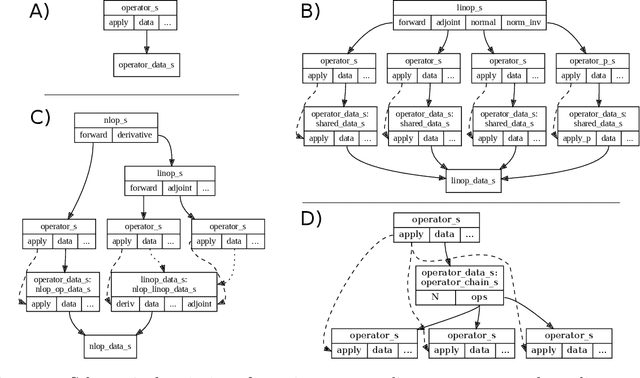
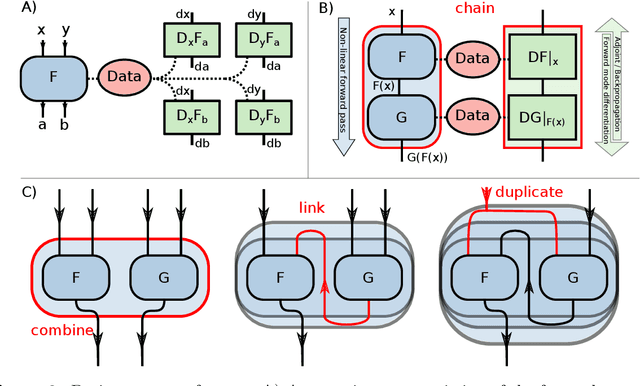
Abstract:Purpose: To develop a deep-learning-based image reconstruction framework for reproducible research in MRI. Methods: The BART toolbox offers a rich set of implementations of calibration and reconstruction algorithms for parallel imaging and compressed sensing. In this work, BART was extended by a non-linear operator framework that provides automatic differentiation to allow computation of gradients. Existing MRI-specific operators of BART, such as the non-uniform fast Fourier transform, are directly integrated into this framework and are complemented by common building blocks used in neural networks. To evaluate the use of the framework for advanced deep-learning-based reconstruction, two state-of-the-art unrolled reconstruction networks, namely the Variational Network [1] and MoDL [2], were implemented. Results: State-of-the-art deep image-reconstruction networks can be constructed and trained using BART's gradient based optimization algorithms. The BART implementation achieves a similar performance in terms of training time and reconstruction quality compared to the original implementations based on TensorFlow. Conclusion: By integrating non-linear operators and neural networks into BART, we provide a general framework for deep-learning-based reconstruction in MRI.
MRI Reconstruction via Data Driven Markov Chain with Joint Uncertainty Estimation
Feb 03, 2022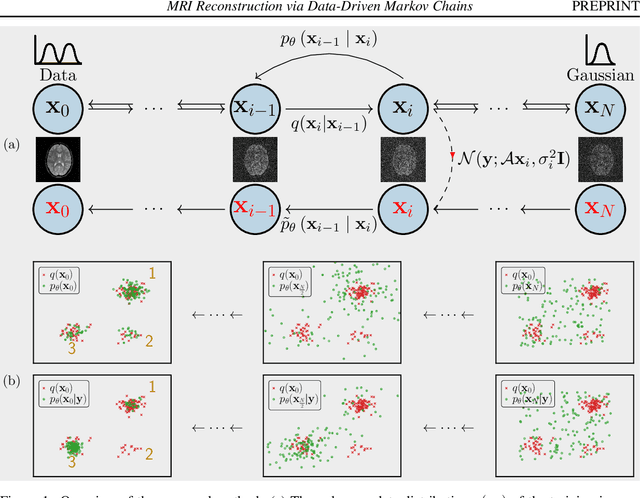
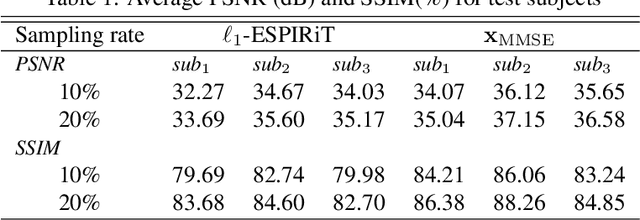
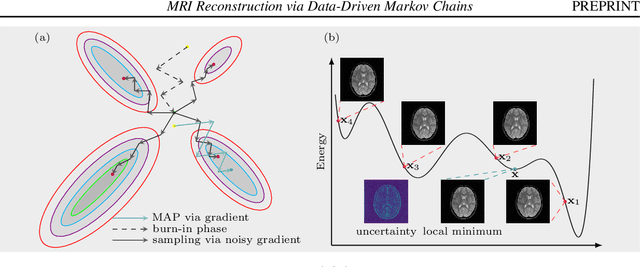
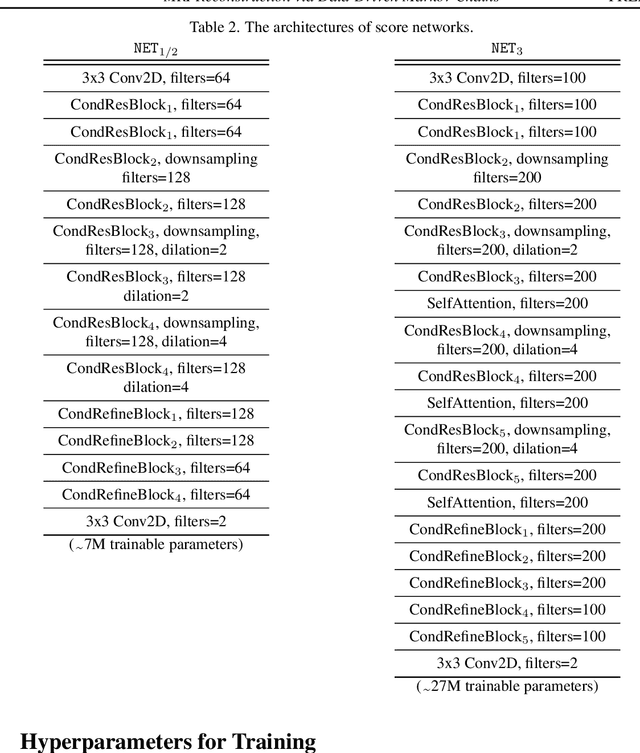
Abstract:We introduce a framework that enables efficient sampling from learned probability distributions for MRI reconstruction. Different from conventional deep learning-based MRI reconstruction techniques, samples are drawn from the posterior distribution given the measured k-space using the Markov chain Monte Carlo (MCMC) method. In addition to the maximum a posteriori (MAP) estimate for the image, which can be obtained with conventional methods, the minimum mean square error (MMSE) estimate and uncertainty maps can also be computed. The data-driven Markov chains are constructed from the generative model learned from a given image database and are independent of the forward operator that is used to model the k-space measurement. This provides flexibility because the method can be applied to k-space acquired with different sampling schemes or receive coils using the same pre-trained models. Furthermore, we use a framework based on a reverse diffusion process to be able to utilize advanced generative models. The performance of the method is evaluated on an open dataset using 10-fold accelerated acquisition.
 Add to Chrome
Add to Chrome Add to Firefox
Add to Firefox Add to Edge
Add to Edge